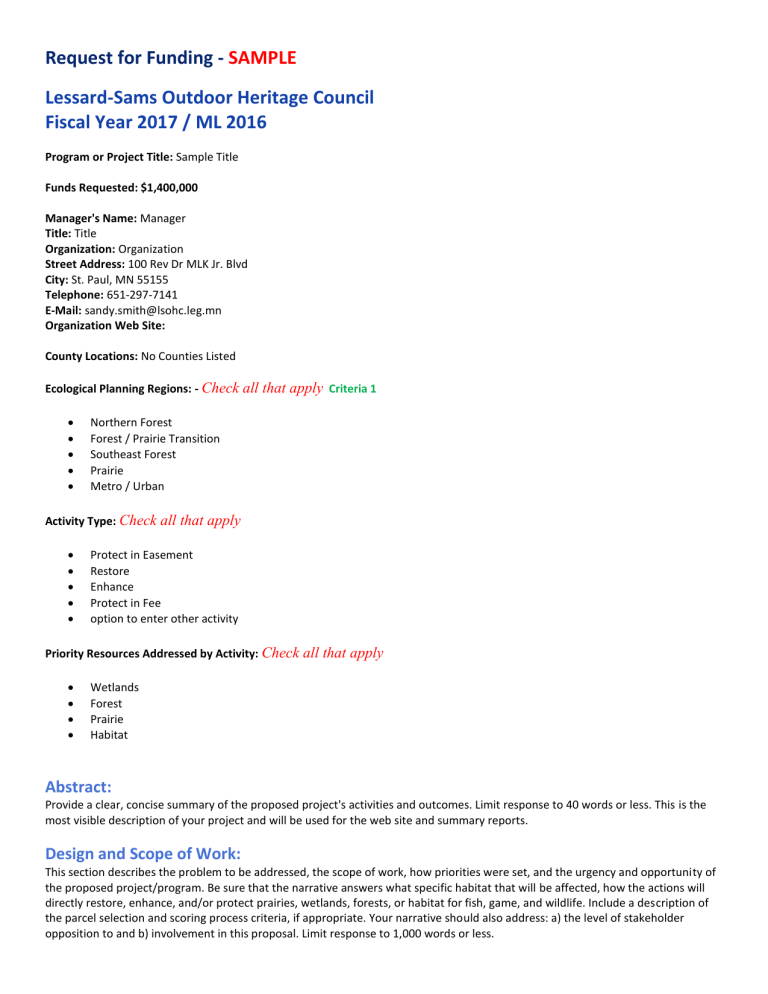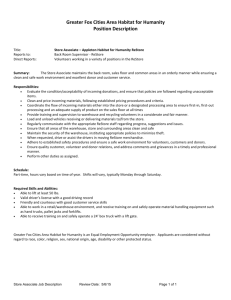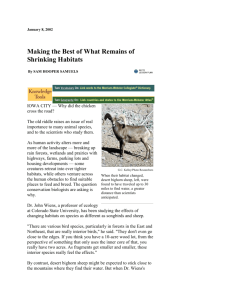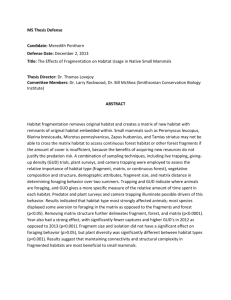Permanent Protection - Lessard-Sams Outdoor Heritage Council

Request for Funding - SAMPLE
Lessard-Sams Outdoor Heritage Council
Fiscal Year 2017 / ML 2016
Program or Project Title: Sample Title
Funds Requested: $1,400,000
Manager's Name: Manager
Title: Title
Organization: Organization
Street Address: 100 Rev Dr MLK Jr. Blvd
City: St. Paul, MN 55155
Telephone: 651-297-7141
E-Mail: sandy.smith@lsohc.leg.mn
Organization Web Site:
County Locations: No Counties Listed
Ecological Planning Regions: - Check all that apply Criteria 1
Northern Forest
Forest / Prairie Transition
Southeast Forest
Prairie
Metro / Urban
Activity Type: Check all that apply
Protect in Easement
Restore
Enhance
Protect in Fee
option to enter other activity
Priority Resources Addressed by Activity: Check all that apply
Wetlands
Forest
Prairie
Habitat
Abstract:
Provide a clear, concise summary of the proposed project's activities and outcomes. Limit response to 40 words or less. This is the most visible description of your project and will be used for the web site and summary reports.
Design and Scope of Work:
This section describes the problem to be addressed, the scope of work, how priorities were set, and the urgency and opportunity of the proposed project/program. Be sure that the narrative answers what specific habitat that will be affected, how the actions will directly restore, enhance, and/or protect prairies, wetlands, forests, or habitat for fish, game, and wildlife. Include a description of the parcel selection and scoring process criteria, if appropriate. Your narrative should also address: a) the level of stakeholder opposition to and b) involvement in this proposal. Limit response to 1,000 words or less.
How the request addresses MN habitats:
Criteria 2
Explain how the request addresses MN habitats that have: historical value to fish and wildlife, wildlife species of greatest conservation need, MN County Biological Survey data, and/or rare, threatened and endangered species inventories? (200 word limit)
Please explain the nature of urgency:
Criteria 3
Please explain the nature of urgency and why it is necessary to spend public money for this work as soon as possible? (50 word limit)
Planning
Please describe the science based planning and evaluation model used:
Criteria 4
Please describe the science based planning and evaluation model used? (50 word limit)
MN State-wide Conservation Plan Priorities: Check the top TWO that apply
H1 Protect priority land habitats
H2 Protect critical shoreland of streams and lakes
H3 Improve connectivity and access to recreation
H4 Restore and protect shallow lakes
H5 Restore land, wetlands and wetland-associated watersheds
H6 Protect and restore critical in-water habitat of lakes and streams
H7 Keep water on the landscape
LU6 Reduce Upland and gully erosion through soil conservation practices
LU8 Protect large blocks of forest land
LU10 Support and expand sustainable practices on working forested lands
Plans Addressed: Check the top TWO that apply
A Vision for Wildlife and Its Use -- Goals and Outcomes 2006-2012
Driftless Area Restoration Effort
Ducks Unlimited Living Lakes Initiative
Grassland Bird Conservation Area
Grassland Conservation Plan for Prairie Grouse
Long Range Duck Recovery Plan
Long Range Plan for Fisheries Management
Long Range Plan for Muskellunge and Large Northern Pike Management Through 2020
Long Range Plan for the Ring-Necked Pheasant in MN
Long Range Plan for the Wild Turkey
Lower St. Louis River Habitat Plan
Managing Minnesota's Shallow Lakes for Waterfowl and Wildlife
Midwest Glacial Lakes Partnership
Minnesota DNR AMA Acquisition Plan
Minnesota DNR Nongame Wildlife Plans
Minnesota DNR Scientific and Natural Area's Long Range Plan
Minnesota DNR Strategic Conservation Agenda
Minnesota Forest Resource Council Landscape Plans
Minnesota Prairie Conservation Plan
Minnesota Sustainability Framework
Minnesota's Wildlife Management Area Acquisition - The Next 50 Years
Mississippi River Headwaters Comprehensive Plan
Moose Advisory Committee Report to the Minnesota DNR
National Audubon Society Top 20 Common Birds in Decline
National Fish Habitat Action Plan
North American Waterbird Conservation Plan
North American Waterfowl Management Plan
Northern Plains Prairie Potholes Regional Shorebird Conservation Plan
Northern Tallgrass Prairie Ecoregion: A River and Stream Conservation Portfolio
Northern Tallgrass Prairie Habitat Preservation Area (HPA) Final Environmental Impact Statement
Outdoor Heritage Fund: A 25 Year Framework
Partners in Flight Conservation Plans for States and Physiographic Regions
Partners in Flight Grassland Bird Plan
Red River of the North Fisheries Management Plan
Ruffed Grouse in Minnesota: A Long-Range Plan for Management
State Comprehensive Outdoor Recreation Plan
Strategic Plan for Coldwater Resources Management in Southeastern Minnesota
Superior National Forest Land and Resource Management Plan
The Nature Conservancy's Superior Mixed Forest Ecoregional Plan
Tomorrow's Habitat for the Wild and Rare
U.S. Fish and Wildlife Service Strategic Habitat Conservation Model
U.S. Prairie Pothole Joint Venture Plan
Upper Mississippi River and Great Lakes Region Projects Joint Ventures Plan
Enter another report here
LSOHC Prairie Section Priorities: Check the top ONE applicable priority
Protect, enhance, or restore existing wetland/upland complexes, or convert agricultural lands to new wetland/upland habitat complexes
Protect, enhance, and restore remnant native prairie, Big Woods forests, and oak savanna
Restore or enhance habitat on public lands
Protect, restore, and enhance shallow lakes
Protect expiring CRP lands
Protect, enhance, and restore migratory habitat for waterfowl and related species, so as to increase migratory and breeding success
Protect from long-term or permanent endangerment from invasive species
LSOHC Forest Prairie Transition Section Priorities: Check the top ONE applicable priority
Protect, enhance, and restore wild rice wetlands, shallow lakes, wetland/grassland complexes, aspen parklands, and shoreland that provide critical habitat for game and nongame wildlife
Protect, enhance, and restore rare native remnant prairie
Protect, enhance, and restore migratory habitat for waterfowl and related species, so as to increase migratory and breeding success
Protect from long-term or permanent endangerment from invasive species
LSOHC Northern Forest Section Priorities: Check the top ONE applicable priority
Protect shoreland and restore or enhance critical habitat on wild rice lakes, shallow lakes, cold water lakes, streams and rivers, and spawning areas
Provide access to manage habitat on landlocked public properties or protect forest land from parcelization and fragmentation through fee acquisition, conservation or access easement
Restore and enhance habitat on existing protected properties, with preference to habitat for rare, endangered, or threatened species identified by the Minnesota County Biological Survey
Restore forest-based wildlife habitat that has experienced substantial decline in area in recent decades
Protect from long-term or permanent endangerment from invasive species
LSOHC Metro Urban Section Priorities: Check the top ONE applicable priority
Protect, enhance, and restore remnant native prairie, Big Woods forests, and oak savanna with an emphasis on areas with high biological diversity
Protect habitat corridors, with emphasis on the Minnesota, Mississippi, and St. Croix rivers (bluff to floodplain)
Enhance and restore coldwater fisheries systems
Protect, enhance, and restore riparian and littoral habitats on lakes to benefit game and nongame fish species
Protect from long-term or permanent endangerment from invasive species
LSOHC Southeast Forest Section Priorities: Check the top ONE applicable priority
Protect forest habitat though acquisition in fee or easement to prevent parcelization and fragmentation and to provide the ability to access and manage landlocked public properties
Protect, enhance, and restore habitat for fish, game, and nongame wildlife in rivers, cold-water streams, and associated upland habitat
Protect, enhance, and restore remnant goat prairies
Restore forest-based wildlife habitat that has experienced substantial decline in area in recent decades
Protect from long-term or permanent endangerment from invasive species
Accelerates or Supplements Current Efforts:
Criteria 5
Explain how this proposal accelerates or supplements your current efforts in this area? (200 Word Limit)
Non-OHF Money Spent in the Past:
Appropriation
Year
2009
2010
ENRTF
Federal Dollars
Source
3,500,000
4,000,000
Amount
2011 Local Tax Levy 1,800,000
Sustainability and Maintenance:
Criteria 6
How will you sustain and/or maintain this work after the Outdoor Heritage Funds are expended? (200 Word Limit)
Maintain Project Outcomes:
Year
2015
2016 fund A fund B
Source of Funds Step 1 step 1 to maintain outcome step 1 to maintain outcome
2017 fund C step 1 to maintain outcome
Applicable Criteria:
Criteria 7 (All proposals will answer)
Step 2 step 2 to maintain outcome
Step 3 step 3 to maintain outcome
If funded, this proposal will meet all applicable criteria set forth in MS 97A.056? - No
If no, explain here
Government Approval:
(Fee proposals will answer)
Will local government approval be sought prior to acquisition? - No
If no, explain here
Permanent Protection:
Criteria 8 (Fee proposals will answer)
Is the land you plan to acquire free of any other permanent protection? - No
If no, explain here
Current Hunting and Fishing Plan:
(Fee proposals will answer)
Is this land currently open for hunting and fishing? - Yes
If yes, explain here
Future Hunting and Fishing Plan:
(Fee proposals will answer)
Will the land be open for hunting and fishing after completion? - Yes
If yes, explain here
Public Use:
(Easement proposals will answer)
Will the eased land be open for public use? - Yes
If yes, explain here
Permanent Protection:
Criteria 8 (Easement proposals will answer)
Is the land you plan to acquire free of any other permanent protection? - No
If no, explain here
Best Management Practice:
(Restore/Enhance proposals will answer)
Will restoration and enhancement work follow best management practices including MS 84.973 Pollinator Habitat Program? - No
If no, explain here
Permanent Protection:
Criteria 8 (Restore/Enhance proposals will answer)
Is the activity on permanently protected land per 97A.056, subd 13(f), tribal lands, and/or public waters per MS 103G.005, Subd. 15?
- No
If no, describe the rationale for restoration and/or enhancement on non-protected land.
Accomplishment Timeline
Activity
Activity 1
Activity 2
Activity 3
Approximate Date
Completed
June 2016
Sept 2017
Dec 2017
Activity 4 January 2018
Outcomes Check the top ONE applicable outcome per region with 100 word text box to explain Criteria 9 & 10
Programs in the northern forest region:
Forestlands are protected from development and fragmentation
Healthy populations of endangered, threatened, and special concern species as well as more common species
Improved aquatic habitat indicators
Increased availability and improved condition of riparian forests and other habitat corridors
Landlocked public properties have increased access for land managers
Greater public access for wildlife and outdoors-related recreation
Improved availability and improved condition of habitats that have experienced substantial decline
Programs in forest-prairie transition region:
Improved aquatic habitat vegetation
Protected, restored, and enhanced aspen parklands and riparian areas
Protected, restored, and enhanced nesting and migratory habitat for waterfowl, upland birds, and species of greatest conservation need
Wetland and upland complexes will consist of native prairies, restored prairies, quality grasslands, and restored shallow lakes and wetlands
Water is kept on the land
Increased waterfowl and upland bird migratory and breeding success
Rivers and streams provide corridors of habitat including intact areas of forest cover in the east and large wetland/upland complexes in the west
Remnant native prairies are part of large complexes of restored prairies, grasslands, and large and small wetlands
Programs in metropolitan urbanizing region:
A network of natural land and riparian habitats will connect corridors for wildlife and species in greatest conservation need
Core areas protected with highly biologically diverse wetlands and plant communities, including native prairie, Big Woods, and oak savanna
Improved aquatic habitat indicators
A forest land base that contributes to the habitat picture
Game lakes are significant contributors of waterfowl, due to efforts to protect uplands adjacent to game lakes
Protected habitats will hold wetlands and shallow lakes open to public recreation and hunting
Programs in southeast forest region:
Healthier populations of endangered, threatened, and special concern species as well as more common species
High priority riparian lands, forestlands, and savannas are protected from parcelization and fragmentation
Landlocked public properties have increased access for land managers
Forestlands and savannas are protected from parcelization and fragmentation and accessible for resource management purposes
Large corridors and complexes of biologically diverse wildlife habitat typical of the unglaciated region are restored and protected
Remnant goat prairies are perpetually protected
Rivers, streams, and surrounding vegetation provide corridors of habitat
Stream to bluff habitat restoration and enhancement will keep water on the land to slow runoff and degradation of aquatic habitat
Programs in prairie region:
Expiring CRP lands are permanently protected
Improved condition of habitat on public lands
Increased participation of private landowners in habitat projects
Protected, restored, and enhanced shallow lakes and wetlands
Restored and enhanced upland habitats
Agriculture lands are converted to grasslands to sustain functioning prairie systems
Increased wildlife productivity
Improved access to public lands
Protected, enhanced and restored remnants of big woods and oak savanna
Remnant native prairies are part of large complexes of restored prairies, grasslands, and large and small wetlands
Improve aquatic vegetation
Enhanced shallow lake productivity
Key core parcels are protected for fish, game and other wildlife
Remnant native prairies and wetlands are perpetually protected and adequately buffered
Water is kept on the land to reduce flood potential and degradation of aquatic habitat
Protected, restored, and enhanced habitat for migratory and unique Minnesota species
Relationship to Other Funds:
Criteria 11
Arts and Cultural Heritage Fund
Environmental and Natural Resource Trust Fund
Clean Water Fund
Parks and Trails Fund
Enter another option here
Describe the relationship of the funds here
Budget Spreadsheet
Criteria 12
Total Amount of Request: $1,400,000
Budget and Cash Leverage
Budget Name
Personnel
Contracts
Fee Acquisition w/ PILT
Fee Acquisition w/o PILT
Easement Acquisition
Easement Stewardship
Travel
Professional Services
Direct Support Services
DNR Land Acquisition Costs
Capital Equipment
Other Equipment/Tools
Supplies/Materials
DNR IDP
Total
LSOHC Request
$100,000
$1,200,000
$0
$0
$75,000
$0
$5,000
$5,000
$0
$5,000
$0
$5,000
$5,000
$0
$1,400,000
Anticipated Leverage Leverage Source
$50,000 County match
$0
$0
$0
$0
$0
$0
$0
$0
$0
$0
$0
$0
$0
$50,000
Total
$0
$5,000
$5,000
$0
- $1,450,000
$150,000
$1,200,000
$0
$0
$75,000
$0
$5,000
$5,000
$0
$5,000
Personnel
Position FTE Over # of years LSOHC Request Anticipated Leverage Leverage Source Total sample person 1 0.00 sample person 2 0.00 sample person 3 1.00
Total 1.00
0.00
0.00
2.00
2.00
$50,000
$50,000
$0
$100,000
$0
$0
$50,000 County match
$50,000
$50,000
$50,000
$50,000
- $150,000
The table below will be automatically calculated based on budgetary table information
Amount of Request:
Amount of Leverage:
$1,400,000
$50,000
Leverage as a percent of the Request: 3.57%
Output Tables
Table 1a. Acres by Resource Type
Type
Restore
Protect in Fee with State PILT Liability
Protect in Fee W/O State PILT Liability
Protect in Easement
Enhance
Total
Wetlands
50
0
0
50
0
100
Prairies Forest Habitats Total
50
0
0
50
0
100
50
0
0
50
0
100
50
0
0
50
0
100
200
0
0
200
0
400
Table 1b. How many of these Prairie acres are Native Prairie?
Type Native Prairie
Restore
Protect in Fee with State PILT Liability
Protect in Fee W/O State PILT Liability
Protect in Easement
Enhance
Total
Table 2. Total Requested Funding by Resource Type
Type
Restore
Protect in Fee with State PILT Liability
Protect in Fee W/O State PILT Liability
Protect in Easement
Enhance
Wetlands Prairies Forest Habitats
$250,000
$0
$0
$100,000
$0
$250,000
$0
$0
$100,000
$0
$250,000
$0
$0
$100,000
$0
$250,000
$0
$0
$100,000
$0
Total
$1,000,000
$0
$0
$400,000
$0
0
0
0
0
0
0
Table 3. Acres within each Ecological Section
Total $350,000 $350,000 $350,000 $350,000 $1,400,000
Type
Restore
Protect in Fee with State PILT Liability
Protect in Fee W/O State PILT Liability
Protect in Easement
Enhance
Total
Metro/Urban Forest/Prairie SE Forest Prairie Northern Forest Total
50
0
0
50
0
100
50
0
0
50
0
100
50
0
0
50
0
100
25
0
0
25
0
50
25 200
0 0
0 0
25 200
0 0
50 400
Table 4. Total Requested Funding within each Ecological Section
Type
Restore
Protect in Fee with State PILT Liability
Protect in Fee W/O State PILT Liability
Protect in Easement
Enhance
Metro/Urban Forest/Prairie SE Forest Prairie Northern Forest
$250,000
$0
$0
$75,000
$0
$250,000 $250,000 $250,000
$0 $0 $0
$0 $0 $0
$75,000 $75,000 $75,000
$0 $0 $0
Total
$25,000 $1,025,000
$0 $0
$0 $0
$75,000 $375,000
$0 $0
Total $325,000 $325,000 $325,000 $325,000 $100,000 $1,400,000
Tables 5 and 6 will be auto-calculated from the information provided above, applicants do not need to calculate or complete
Table 5. Average Cost per Acre by Resource Type
Type
Restore
Protect in Fee with State PILT Liability
Protect in Fee W/O State PILT Liability
Protect in Easement
Enhance
Table 6. Average Cost per Acre by Ecological Section
Wetlands
$5,000
$0
$0
$2,000
$0
Prairies
$5,000
$0
$0
$2,000
$0
Forest
$5,000
$0
$0
$2,000
$0
Habitats
$5,000
$0
$0
$2,000
$0
Type
Restore
Protect in Fee with State PILT Liability
Protect in Fee W/O State PILT Liability
Protect in Easement
Metro/Urban Forest/Prairie SE Forest Prairie Northern Forest
$5,000
$0
$0
$1,500
$5,000
$0
$0
$1,500
$5,000 $10,000
$0 $0
$0 $0
$1,500 $3,000
$1,000
$0
$0
$3,000
Enhance
Target Lake/Stream/River Miles
15 miles
$0 $0 $0 $0 $0
Parcel List
Complete the parcel tab as accurately as possible. The system will automatically generate a “dot” map from the TRDS provided. Inaccurate completion of this data will not represent all of the activity locations in your proposal.
Section 1 - Restore / Enhance Parcel List
Benton
Name
Restore Parcel
Clearwater
Name
Enhance Parcel
2
2
TRDS
TRDS
Acres
Acres
0
0
Est Cost
Est Cost
$0
$0
Existing Protection?
Existing Protection?
Section 2 - Protect Parcel List
Cottonwood
Name
Protect in Fee Parcel w/PILT
2
Pennington
Name
Protect in Fee Parcel w/o PILT
2
Polk
Name
Protect in Easement 2
TRDS
TRDS
TRDS
Acres
Acres
Acres
0
0
0
Est Cost
$0
Existing Protection?
Est Cost
$0
Existing Protection?
Est Cost
$0
Existing Protection?
Hunting?
Hunting?
Hunting?
Fishing?
Fishing?
Fishing?
Section 2a - Protect Parcel with Bldgs
No parcels with an activity type protect and has buildings.
Section 3 - Other Parcel Activity
Pipestone
Name
Other with Bldg
Renville
Name
Not applicable
2
2
TRDS
TRDS
Acres
Acres
0
0
Est Cost
$0
Existing Protection?
Est Cost
$0
Existing Protection?
Hunting?
Hunting?
Fishing?
Fishing?








